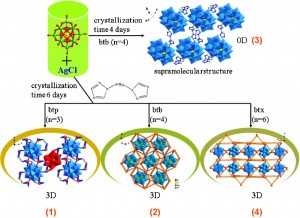Polyoxometalates (POMs) have been widely used as the inorganic component in metal-organic frameworks to construct structures with complex topologies for a variety of functions. These structures tend to be constructed from metal ions and N-containing ligands. Flexible N-donor ligands, such as the bis(triazole) ligands with different spacers of –(CH2)n– (where n = 2, 3, 4, 5, 6), offers even more advantages over their rigid counterparts as the flexibility enables them to form more complex structures.
In this paper, the authors synthesised four compounds based on the PW12O403-–AgI–bis(triazole) system to investigate how the different spacer lengths in the bis(triazole) ligands, and the reaction conditions such as pH and crystallisation time, has on the final topology of the structure. They also studied the electrochemical and photocatalytic properties of these structures, and obtained some very promising results.
The following are some of the fascinating structures that they made.
Find out more about them, and their synthetic methods, from the paper now:
A series of 3D PW12O403--based AgI–bis(triazole) complexes containing different multinuclear loops: syntheses, structures and properties
Xiuli Wang, Dan Zhao, Aixiang Tian and Jun Ying
CrystEngComm, 2013, Advance Article
DOI: 10.1039/C3CE40375K, Paper
 |
Wendy is the Development Editor of CrystEngComm. She started working for the RSC in March 2013, after completing her PhD at the University of Cambridge. |











